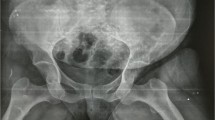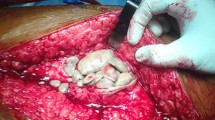Abstract
Bilateral posterior hip dislocations are extremely rare. Symmetric dislocations can be easily missed out. A 74-year-old man presented to the emergency department after sustaining a dashboard injury. The right hip showed a dislocation clinically and radiographically. The left hip joint had a fracture dislocation which was confirmed radiographically. The right hip joint post-reduction was stable but the left hip joint was highly unstable after reduction and was managed with posterior fixation. After fixation, the left hip joint was fully stable and the patient had an excellent prognosis at follow-up of 1 year. The mechanism of injury must be properly studied and a strong suspicion must be kept for concomitant dislocation in the presence of a high-velocity injury as clinical examination in these situations can be misleading. Once adequately diagnosed, the treatment protocols are simple and the outcomes are excellent for the patient.
Similar content being viewed by others
Avoid common mistakes on your manuscript.
Introduction
Posterior hip dislocation is the most common type of hip dislocation with more than 90% occurrence [1, 2]. Bilateral hip dislocation is a rare injury with only about 104 cases reported in the literature. Mostly, reported cases are asymmetric with one of the hips being anteriorly dislocated and the other posteriorly. The incidence of symmetric bilateral dislocations is further less [3]. Bilateral posterior dislocation is common in male patients occurring as a result of dashboard injury. It is an orthopedic emergency; early detection and reduction is essential to prevent long-term complications [4, 5]. We present a case report of a 74-year-old male patient with bilateral symmetric posterior dislocation of hip joints. The patient had a transverse plus posterior wall fracture of the left acetabulum.
Case Report
A 74-year-old male patient presented to the hospital after sustaining a dashboard injury. The patient was seated in the backseat of a bus and during a collision sustained a dashboard injury. Multiple abrasions were present over both the knees and trochanteric regions. There was no neurovascular deficit. The right lower limb was held in an attitude of flexion, adduction, and internal rotation.
The radiographs showed posterior dislocation of the right hip joint with the head lying posterior superiorly. A transverse plus posterior wall fracture of the left acetabulum was also visualized with the head lying medially and superiorly (Fig. 1).
Closed reduction of the bilateral hip joints was planned under general anesthesia. The patient was taken to the operation theater approximately 3 h after injury. The right hip was reduced using Allis maneuver and the stability of the hip was checked by loading at 30°, 60°, and 90° of hip flexion. The right hip was found to be stable. Thereafter, reduction of the left hip joint was attempted. The left hip joint was found to be highly unstable, dislocating at even 0 degree of flexion on loading (Fig. 2). The CT scan showed the left femoral head to be dislocated and lying posteriorly. A transverse plus posterior wall of the left acetabulum was visualized (Fig. 3). The 3D reconstruction images further helped to delineate the fracture (Fig. 4 and Fig. 5).
A plan for open reduction and fixation of the acetabular fracture was made.
Multiple comorbidities in the form of diabetes, poor cardiac output, and chronic kidney disease were observed. The patient also had fractures of the maxilla and mandible.
Considering the patient’s comorbidities and general status, a primary plan for posterior fixation was made. The plan for anterior fixation was to be decided intra-operatively depending on the stability after posterior fixation.
After general anesthesia, the patient was placed in a left lateral position. A Kocher-Lagenback approach was used. Type 2 bleeding of the femoral head was visualized and the hip joint was inspected for any intra-articular fragments. Thereafter, reduction of the femoral head was done and fixation of the posterior column and posterior wall was done. The hip joint stability was checked and the anterior column was managed conservatively. After that, the patient was taken in a right lateral position and the right hip joint was cleared of intra-articular fragments. The post-operative X-ray showed both the hip joints in well reduced position (Fig. 6). Skin traction was applied to bilateral lower limbs and pelvic lifting was allowed. After 3 weeks, the patient was allowed high sitting and wheel chair mobilization was done. Weight bearing with walker was allowed at the end of 6 weeks. At 3 months, the patient was weight bearing with stick (Fig. 7). At 1 year follow-up, the patient is completely pain-free and walking without support (Fig. 8, Fig. 9, and Fig. 10).
Discussion
The first case of bilateral hip dislocation was reported by Singowitz in 1830 [6]. A total of 13 reported cases were reviewed by Packard in 1883 in which there were 8 asymmetric, 3 bilateral posterior, and 2 bilateral anterior dislocations highlighting the rarity of bilateral symmetric dislocations [7]. Epstein’s series of 583 hip dislocations identified 10 bilateral dislocations with 8 being asymmetric and 1 each symmetric [8, 9]. Brav’s review of 517 patients identified 6 bilateral dislocations with 3 being asymmetric and only 1 being bilateral posterior dislocation further highlighting the rarity of the injury [10]. Thus, bilateral posterior dislocations of the hip joint are among the rare injuries reported in literature.
The effect of gender on dislocations is seen as most of the reported cases are male. The higher incidence is attributed to greater retroversion or reduced anteversion in males making them susceptible to posterior dislocations [11]. Furthermore, the females also have more anteverted acetabuli in addition to anteverted femoral heads for acceptance of greater axial femoral loads thus being less susceptible to posterior dislocations [12].
The hip joint capsule is weakest in the posterior region so the chances of posterior dislocation are higher. The iliofemoral ligament is located anteriorly, being the strongest ligament in the body helps to prevent dislocation anteriorly. The ischiofemoral ligament helps to prevent dislocation posterior superiorly but it is not as strong as the iliofemoral ligament. Furthermore, as the hip joint is in a position of flexion, the force vector causes it to dislocate posteriorly [13]. The most common mechanism of injury is a road vehicle accident. Both the hip joints may have dislocated simultaneously or one by one with the first one occurring at the time of injury and the second during extrication [2, 14].
A thorough clinical examination is not able to always establish the diagnosis of a bilateral dislocation. As both the hip joints are dislocated, so limb length discrepancy does not help. The lower limbs may be held in a position of flexion, adduction, and internal rotation but if there is a fracture of the posterior wall, the dislocation can be missed [15]. In addition to routine X-rays, a CT scan should also be done before reduction if the X-ray is suggestive for wall and/or column fractures. This can help in establishing the diagnosis [16]. It is also imperative to document neurovascular status as the posterior dislocation can lead to pressure on the sciatic nerve [9]. The presence of other concomitant injuries must be looked into as both the hip joints are dislocated. The presence of bilateral dislocation itself suggests that the injury is a high-velocity injury [2].
Emergent reduction is the standard protocol of management that should be essentially followed. Following reduction, the stability of the joint should be assessed by loading at 30°, 60°, and 90° [10, 17]. Weight bearing should be based on the pattern of injury, although weight bearing does not affect the outcome. The maximum literature suggests limiting weight bearing for some time after the injury [9, 17].
The general outcome of bilateral dislocations is good [7]. Considering the number of limited cases reported in literature, a consensus is difficult to establish.
Conclusion
Bilateral symmetric dislocations of the hip joint are a rare injury. These injuries are even less common than asymmetric bilateral hip dislocations. The mechanism of injury must be properly studied and a strong suspicion must be kept for concomitant dislocation in the presence of a high-velocity injury as clinical examination in these situations can be misleading. Once adequately diagnosed, the treatment protocols are simple and the outcomes are excellent.
References
Brauer CA, Coca-Perraillon M, Cutler DM, Rosen AB. Incidence and mortality of hip fractures in the United States. JAMA. 2009;302(14):1573–9.
Stewart MJ, Milford LW. Fracture-dislocation of the hip; an end-result study. J Bone Joint Surg Am. 1954;36:315–42.
Hamilton DA Jr, Wright RD Jr, Moghadamian ES, Bruce BT, Selby JB. Bilateral asymmetric hip dislocation: a case series and literature review of a rare injury pattern. J Trauma Acute Care Surg. 2012;73:1018–23.
Dawson-Amoah K, Raszewski J, Duplantier N, Waddell BS. Dislocation of the hip: a review of types, causes, and treatment. Ochsner J. 2018 Fall;18(3):242–52.
Nicholson JA, Scott CEH, Annan J, Ahmed I, Keating JF. Native hip dislocation at acetabular fracture predicts poor long-term outcome. Injury. 2018;49(10):1841–7.
Niehaus P. Ueber traumatische Luxationen bedier Huftgelenke. German Journal for Surgery. 1888;27:467–94.
Packard JH. Simultaneous traumative dislocation of both hip joints. J Am Med Assoc. 1883;1:193–6.
Epstein HC. Traumatic dislocations of the hip. Clin Orthop Relat Res. 1973;92:116–42.
Thompson VP, Epstein HC. Traumatic dislocation of the hip; a survey of two hundred and four cases covering a period of twenty-one years. J Bone Joint Surg Am. 1951;33-A:746–78 passim.
Brav EA. Traumatic dislocation of the hip army experience and results over a twelve-year period. J Bone Joint Surg. 1962;44:1115–34.
Upadhyay SS, Moulton A, Burwell RG. Biological factors predisposing to traumatic posterior dislocation of the hip. A selection process in the mechanism of injury. J Bone Joint Surg Br. 1985;67:232–6.
Sah AP, Marsh E. Traumatic simultaneous asymmetric hip dislocations and motor vehicle accidents. Orthopedics. 2008;31:613.
Bigelow HJI. The mechanism of dislocations and fracture of the hip. Little, Brown, and Company; 1900.
Sinha SN. Simultaneous anterior and posterior dislocation of the hip joints. J Trauma. 1985;25:269–70.
Su Y, Chen W, Zhang Q, Li B, Li Z, Guo M, et al. An irreducible variant of femoral neck fracture: a minimally traumatic reduction technique. Injury. 2011;42:140–5.
Tornetta P. Rockwood and Green’s fractures in adults. 5th ed. Hip dislocations and fractures of the femoral head. Philadelphia: Lippincott Williams & Wilkins; 2001. pp. 1547–78.
Stewart MJ, McCarroll HR Jr, Mulhollan JS. Fracture-dislocation of the hip. Acta Orthop Scand. 1975;46:507–25.
Author information
Authors and Affiliations
Corresponding author
Ethics declarations
Conflict of Interest
The authors declare that they have no conflict of interest.
Ethical Approval
All procedures performed in studies involving human participants were in accordance with the ethical standards of the institutional and/or national research committee and with the 1964 Helsinki declaration and its later amendments or comparable ethical standards.
Informed Consent
The patient was informed that the data concerning the treatment would be published and consented for the same.
Additional information
Publisher’s Note
Springer Nature remains neutral with regard to jurisdictional claims in published maps and institutional affiliations.
Rights and permissions
About this article
Cite this article
Mittal, N., Bohat, R., Kapoor, A. et al. A Case Report of Bilateral Symmetric Posterior Hip Dislocation: Why It Is More Common in Males?. SN Compr. Clin. Med. 3, 382–387 (2021). https://doi.org/10.1007/s42399-020-00668-4
Accepted:
Published:
Issue Date:
DOI: https://doi.org/10.1007/s42399-020-00668-4














